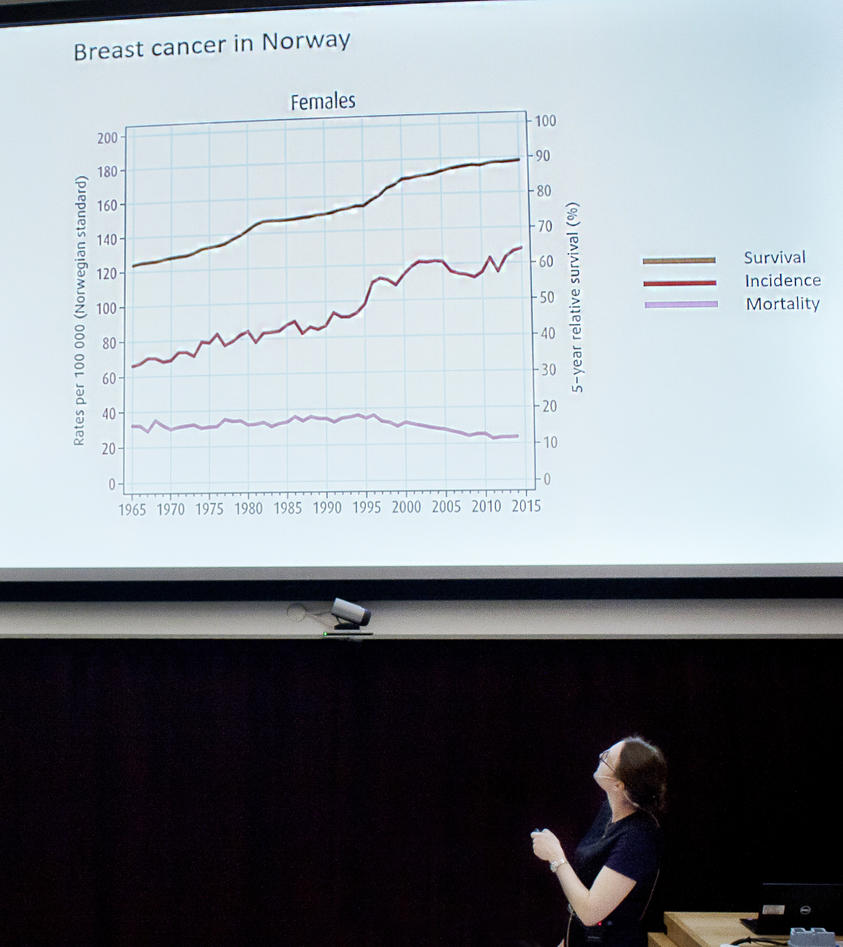Better understanding of breast cancer
Marit Valla defended October 12th 2017 her PhD dissertation "Molecular subtypes of breast cancer: incidence and prognosis". This was a collaboration project between the Centre for Cancer Biomarkers (CCBIO), University of Bergen (UiB), and the Department of Public Health and Nursing, the Norwegian University of Science and Technology (NTNU).

Hovedinnhold
Main supervisor was Professor Anna M. Bofin, Department of Clinical and Molecular Medicine, NTNU. Co-supervisors were Researcher Signe Opdahl, Department of Clinical and Molecular Medicine, NTNU and Professor Lars A. Akslen, CCBIO, UIB.
Background
The incidence of breast cancer has increased in the Western world in the last decades, and in Norway there has been a doubling of incidence since the Cancer Registry started its monitoring of the number of cancer cases in 1952. Mortality has fallen since the mid-1990s. In developing countries, incidence is usually lower, and mortality is higher.
Breast cancer is a heterogeneous disease with great variation in both etiology, morphology, effect of treatment and prognosis. In a 2000 work (Perou et al., Nature, 2000), breast tumors were divided into subgroups (molecular subtypes) based on variation in gene expression patterns. In recent studies, several different algorithms and definitions of molecular subtypes have been used, and it has been shown that different molecular subtypes have different prognoses. Furthermore, established methods such as immunohistochemistry (IHC) and in situ hybridization (ISH) can be used as surrogates for gene expression assays in the molecular subtyping.
Long-term trends of molecular breast cancer subtypes
In the dissertation "Molecular subtypes of breast cancer: incidence and prognosis", Marit Valla and colleagues have studied two cohorts of a population of Norwegian women born between 1886 and 1977. By linking to national registries, these women were followed for the occurrence of breast cancer in the period 1961 to 2009. Those who developed breast cancer were followed until 2013.
Using IHC and ISH, breast cancer tumors that occurred in this population were reclassified into six different molecular subtypes: Luminal A, Luminal B (HER2), Luminal B (HER2 +), HER2 type, 5 negative phenotype and Basal phenotype. A total of 1423 tumors were subtyped.
The first part of the dissertation deals with time trends for the incidence and prognosis of the molecular subtypes of breast cancer. In the age group 50-69, a clearly higher breast cancer incidence was found among women born in 1929 or later, compared to those born before 1929. However, this increase was limited to two of the subtypes (Luminal A and Luminal B (HER2-)). The prognosis was better among women diagnosed in 1995 or later, compared with those diagnosed before 1995. Clear improvement in prognosis was only seen for three of the subtypes (Luminal A, Luminal B (HER2), and Basal phenotype).
In the second work, tumors were divided into new groups based on the number of copies of FGD5, a gene identified as a driver of proliferation in luminal breast cancer. Cell proliferation is important for cancer development, and high proliferation is associated with poorer prognosis. FGD5 amplification was associated with higher proliferation in cancer tumors, and poorer prognosis.
In the third work, FGD5 protein expression in breast cancer tissue and associated lymph node metastases were examined using IHC. There was a higher proportion of patients with FGD5 expression in the lymph nodes than in the associated primary tumors. There was no reliable association between FGD5 expression in primary tumors and proliferation or prognosis.
Increased understanding of breast cancer
This work has contributed to increased understanding of time trends in the incidence and prognosis of the molecular subtypes of breast cancer, and to a further division of breast cancer tumors in phenotypic and prognostic groups.
